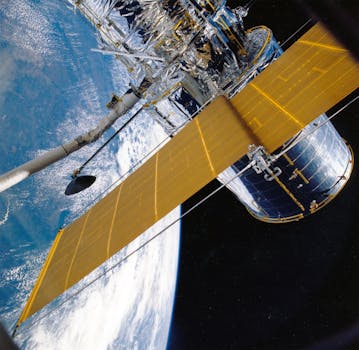
The Future of Satellites: Revolutionizing Global Connectivity
The future of satellites is revolutionizing global connectivity, with advancements in space technology and increasing demand for global connectivity. The focus keyword Future of Satellites is an essential aspect of this revolution, as it enables the development of new satellite technologies and services. As the world becomes increasingly dependent on digital communication, the need for reliable and efficient satellite systems has never been more pressing. In this article, we will delve into the latest trends and innovations in the satellite industry, exploring the exciting developments that are shaping the future of satellites.
Satellites have been a crucial part of our daily lives for decades, providing essential services such as navigation, communication, and weather forecasting. However, the traditional satellite industry has been limited by high costs, complex infrastructure, and restrictive regulations. The advent of new space technologies and business models is disrupting the status quo, enabling the deployment of smaller, cheaper, and more efficient satellites. This shift is opening up new opportunities for satellite-based services, including broadband internet, earth observation, and satellite-based navigation.
Advances in Satellite Technology
One of the most significant advances in satellite technology is the development of small satellites, also known as CubeSats. These tiny satellites, which weigh less than 1.33 kilograms, are relatively inexpensive to build and launch, making them an attractive option for startups and researchers. Small satellites are being used for a variety of applications, including earth observation, communication, and scientific research. For example, the Planet Labs constellation of small satellites is providing high-resolution images of the earth, enabling applications such as crop monitoring, disaster response, and environmental monitoring.
Another area of innovation is the development of reusable launch vehicles, which are reducing the cost of accessing space. Companies such as SpaceX and Blue Origin are pioneering reusable launch technology, enabling the launch of satellites and other spacecraft at a significantly lower cost. This is making space more accessible to a wider range of players, including startups and developing countries. The reduced cost of launch is also enabling the deployment of larger constellations of satellites, which are providing global coverage and enabling new services such as satellite-based broadband internet.
Emerging Trends and Applications
The future of satellites is not just about technological advancements; it is also about emerging trends and applications. One of the most exciting developments is the growth of satellite-based broadband internet. Companies such as OneWeb and Amazon’s Kuiper Systems are launching large constellations of satellites to provide global internet coverage. This will enable remote and underserved communities to access high-speed internet, bridging the digital divide and enabling new opportunities for economic development.
Another area of growth is earth observation, which is being driven by the increasing demand for data and insights about our planet. Satellites are being used to monitor climate change, track natural disasters, and provide critical information for agriculture, forestry, and urban planning. The European Space Agency’s Copernicus program, for example, is providing free and open access to satellite data, enabling researchers and policymakers to make informed decisions about the environment and natural resources.
Challenges and Opportunities
Despite the many advances and innovations in the satellite industry, there are also challenges and opportunities that need to be addressed. One of the biggest challenges is the issue of space debris, which is posing a significant threat to the long-term sustainability of space activities. The increasing number of satellites in orbit is generating a growing amount of debris, which can collide with operational satellites and cause damage or even destruction.
Another challenge is the need for regulatory frameworks that can keep pace with the rapid evolution of the satellite industry. The current regulatory environment is often fragmented and outdated, making it difficult for new players to enter the market and for innovative services to be deployed. There is a need for more flexible and adaptive regulatory frameworks that can enable the growth of the satellite industry while ensuring safety, security, and sustainability.
In conclusion, the future of satellites is rapidly evolving, with advancements in space technology and increasing demand for global connectivity. The focus keyword Future of Satellites is an essential aspect of this revolution, as it enables the development of new satellite technologies and services. As the satellite industry continues to grow and innovate, it is essential to address the challenges and opportunities that arise, ensuring that the benefits of satellite technology are available to all and that the long-term sustainability of space activities is protected.



